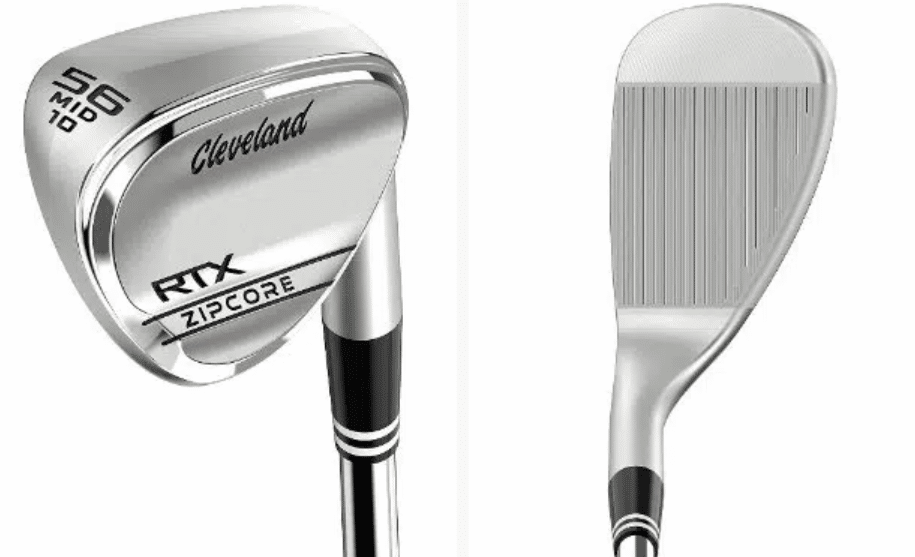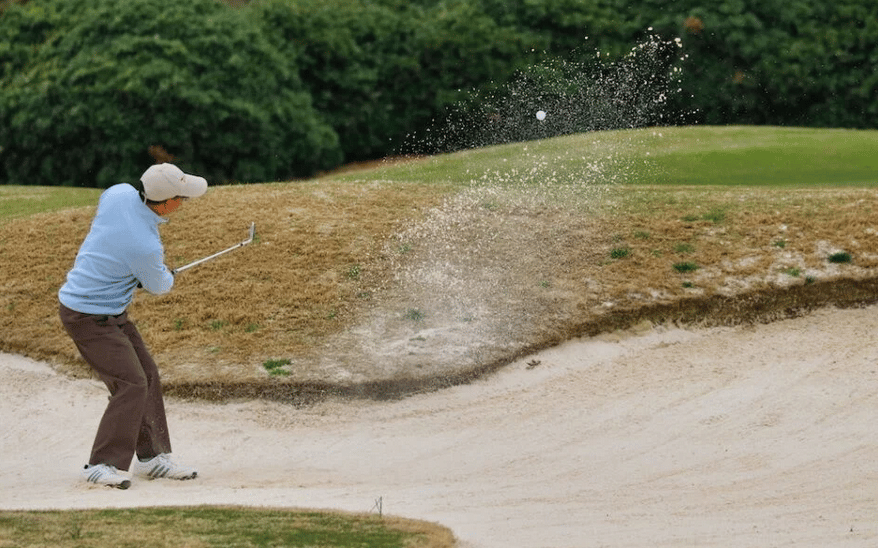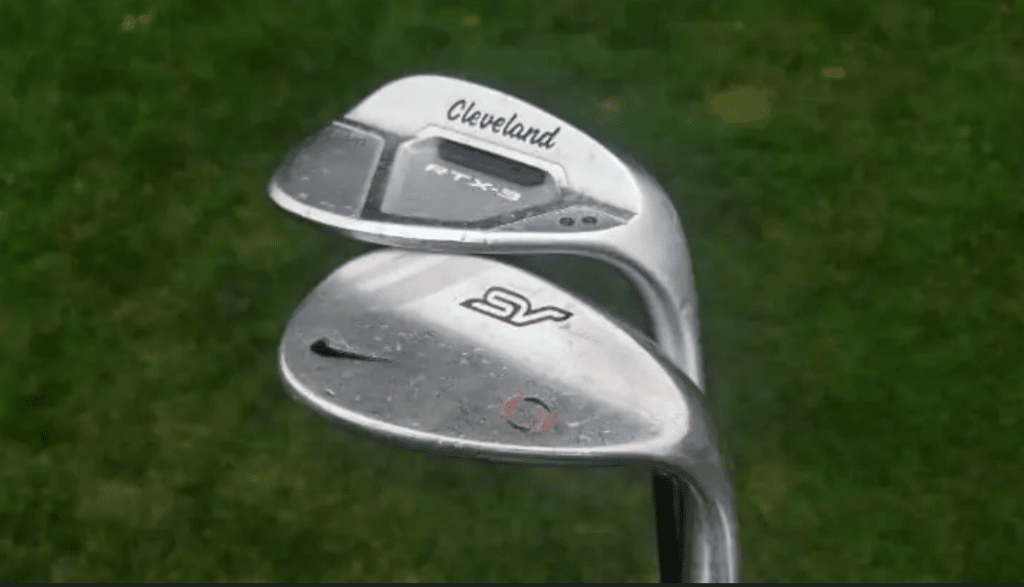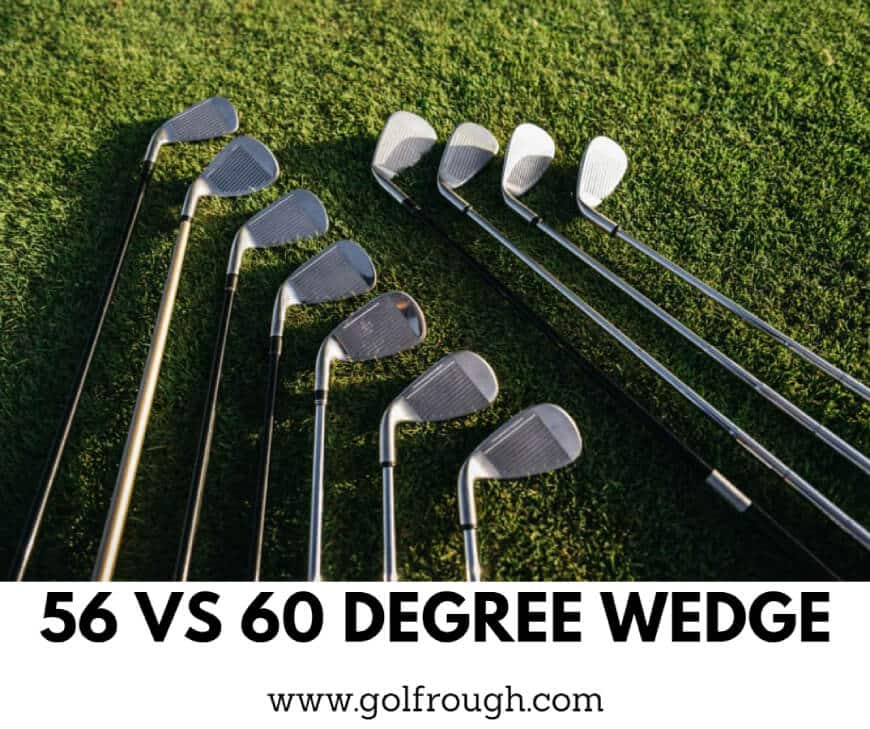Even if you are a veteran or a beginner, you will find yourself asking which wedge to use around the green. After all, you want to increase your chances of winning a game.
Most golfers think that they only require one wedge for every shot they hit around the green. However, each may need a different type of shot requiring you to have more than one wedge.
In most cases, experienced golfers may use one golf club for minor adjustments. Average or beginner golfers, on the other hand, find it easier to use different wedge lofts to simplify the golf game.
The most commonly played wedges in golf courses are the 56- and 60-degree wedges. If you’re unsure which golf club to put in your bag and which to grab and swing with, this article will help you figure it out.
The 56-Degree Wedge

What is a 56-degree Wedge used for?
A 56-degree wedge, also known as the sand wedge, offers a higher degree of bounce to enable golfers to move smoothly through the dirt and sand. Golfers should have the 56-degree wedge in their golf bag to ensure they are not stuck in sticky situations.
The 56-degree wedges are mostly suitable for chipping around the green area. It can be best for a golfer who hits behind the golf ball too much. This helps them bounce the ball off the dirt and sand, becoming a versatile option to carry around in their bags. However, an average golfer should only use it when they are stuck in a pit of a sandy or wet, muddy area.
Who should use the 56-Degree Wedge
Meanwhile, the 56-degree wedge can be used by everyone. If you are trapped in the sand, it will help you get out. However, it is commonly used by golfers to help them glide through tough situations.
When to use a 56-Degree Wedge?
The 56-degree wedge is ideal to use when you tend to hit behind the ball many times. When hitting from the fairway, the 56-degree wedge is a good choice. Its higher bounce enables the club to glide through the sand and not do much digging. You can use the golf club to chip out of the thick grass and get your golf ball.
Use a 56-degree wedge only to get the ball out of the sand or muddy trap. Also, when you’re aiming the ball to overcome an obstacle that needs hard-hitting. So, having them around can give you an edge in similar situations to any other club type.
How far should you hit a 56-degree wedge?
How far you hit the 56-degree wedge depends on your level of clubhead speed. If you are a golfer with a high level of clubhead speed, you can hit your 56-degree wedge between 100 and 125 yards. If your swing speed is slow, you can hit the club from anywhere between 70 and 100 yards.
Finally, a professional can hit it high above a distance of around 115-120 yards with a 56-degree wedge.
How to hit a 56-Degree Wedge?
There are several keys on hitting hit a 56-degree wedge depending on your situation. They include situations like what your lie is, where you are, and the shot you are hitting.
To hit your 56-degree wedge when you have a good lie in a greenside bunker, you need to play it like you would with any normal bunker shot. This means you should never overswing, and you should play the ball a bit close to your back foot.
At the same time, you want to put a bit more weight into your front foot and remain smooth after the contact.
The 60-Degree Wedge

What is a 60-degree wedge used for?
A 60-degree wedge, also known as a lob wedge, is used to get the ball high in the air and get it to stop on the green. If you land in a bunker around the green’s edge, the 60-degree wedge works well. It is ideal for hitting shorter chip shots.
Who should use the 60-Degree wedge?
Most would suggest that a 60-degree wedge should only be used by more experienced golfers. The reason is that there is a possibility of messing with the shot which can lead to your round falling apart.
When to use a 60-Degree Wedge?
A 60-degree wedge is suitable when you are chipping near the green. The situations when you should use the 60-degree wedge include when the golf ball is behind the bunker. Also, your golf ball is slightly rough off the green.
How far should you hit a 60-degree wedge?
How far you hit a golf club depends on how you make contact with the ball and swing speed. If you swing the club hard, you can reach more than 100 yards, but if you have a slower swing, the golf club can fly up to 50 yards or so.
How to hit a 60-Degree Wedge?
To hit a lob wedge, you have to keep your hands quiet and then let the golf club swing and ensure you are well-fitted. Your head should face the target naturally, and you should make sure you are balanced.
When aiming for a big swing using the 60-degree wedge, you want to make sure that the ball is placed in the center of your stance. You should also add a bit of weight on the front. However, even if you properly executed the shot, the angle will be a bit less than 60 degrees.
Do pros use 60-degree wedges?
Yes, pros have the 60-degree wedge in their golf bag. A high lofted wedge helps golf professionals to hit shorter distances. Also, as a pro, you will find it difficult to escape the bunker. The wedge with extra loft will give you the performance required in the green.
Do I need a 60-Degree Wedge?
It depends on your golf skills. The golf club is a huge asset to experienced golfers and can be a liability to average or beginner golfers. Therefore, carry a 60-degree wedge if you are a seasoned golfer.
What’s The Difference Between The 56- and 60-Degree Wedges?
A 56-degree wedge is more beneficial because it’s more versatile while a 60-degree wedge is only suitable for better golfers.
A 60-degree wedge is a higher lofted club than a 56-degree wedge. There is a difference of 4 degrees. If you are chipping or hitting a shot, and you want to clear a tree, 60-degree is more suitable.
56 vs 60 Degree Wedges: Full shot
A full shot can be a great way to compare the performance of both the 56- and 60-degree wedges from the fairway.
Distances are more consistent while using a 56-degree wedge while distances of the 60-degree wedge lack continuity.
The margin for errors is much smaller with the 60-degree wedge compared to the 56-degree wedge where there are more errors. With the lob wedge, you will hit thin shorts making the yardage wider.
The average distance when using your sand wedge is higher compared to that of the lob wedge which is less.
The sand degree wedge performs well in full shots due to its versatility while the lob wedge is not adaptable to different hits.
56 vs 60 Degree Wedges: Chip Shot
When hitting over the bunker, the 60-degree wedge is more solid compared to the sand-degree wedge.
The 60-degree wedge performance from the fairway is good but struggles from the rough because of the fat shots. The 56-degree wedge has a high-degree bounce that prevents it from digging too far into the ground.
Should You Get A 56 Or 60 Degree Wedge?

Both sand and lob-degree wedges have their strengths and weaknesses. Even so, both golf clubs play a purpose in your golf bag and make the golf game easier.
Using a 56- and 60-degree wedge will enable you to take your golf game to the next level. However, depending on your level of skills on the golf course, choose a wedge that will be suitable for your golf game.
If you’re the type of golfer who tends to hit behind your golf a lot, then the 56-degree wedge would be highly ideal for you. On the other hand, if you prefer launching the ball high up in the air, then you’re better off with the 60-degree wedge.
Just keep in mind that the 60-degree version will require a higher skill level.
Frequently Asked Questions
1. Do you need a 56 and a 60 Degree Wedge?
For a professional golfer, having both a 56 and a 60-degree wedge is essential in your game. The lob wedge is suitable for shorter shots which are made by golfers with experience in the course.
For an average golfer, having both 56- and 60-degree wedges is unnecessary. This is because as an average golfer, you need a golf club that is more versatile and with the highest wedge loft. Therefore, a 56-degree wedge is more convenient for beginners and average golfers.
As you get better with the game, you can add the lob wedge to your bag. But until then, the 60-degree wedge is unnecessary.
2. Should a high handicapper use a 60-degree wedge?
No, high handicappers should carry a 56-degree wedge. This wedge is easier to hit and great at controlling distance. A 60-degree degree wedge is more appropriate for lower handicap and scratch golfers as it is perfect for hitting bunkers around the green.
The 60-degree wedge has the greatest loft and is designed for short shots on the pitch. This makes it unsuitable for high handicappers because they aim for longer shots.
However, for high handicappers who are can’t play from tight, lies, and take large divots, they can use the 60-degree wedge. This is a rare scenario on the golf course.
3. Is it better to chip with a 56- or 60-degree wedge?
It is better to chip with a 56-degree wedge other than a 60-degree wedge. This is because a golf club with 56 degrees of the loft has the right height, maneuverability, and spin. This allows you to get shots and complete them with ease around the green.
Conclusion
Hopefully, this article has guided you on both the 56- and 60-degree wedges. Knowing when you should use a 56- and 60-degree wedge can make you great on the golf course.
We hope you now have a better understanding of the two golf clubs. To have a better knowledge of them, you can spend enough time practicing the shots. With time you will know which type of wedge is required during gameplay to enhance your scores.
However, we would recommend the 56-degree wedge because you can approach your shots to the green. Also, shots outside the bunker are excellent with this wedge. This makes it a scoring hole and can make or break your entire golf round.
The sand wedges also have a high degree of bounce and prevent the golf club from digging into the sand.
Read more:
- Are Chippers Legal In Golf
- 5 Hybrid vs 5 Iron ? Which Should You Use ?
- What Wedges Should A Beginner Carry? (Are Two Wedges Enough?)
Matt Stevens is the founder of Golfrough.com. He holds a Postgraduate in Sports Marketing and has played golf since he was four years old. Having experienced every high and low golf has to offer, his writing helps the average golfer avoid the mistakes he has made in 28-years on the course.

